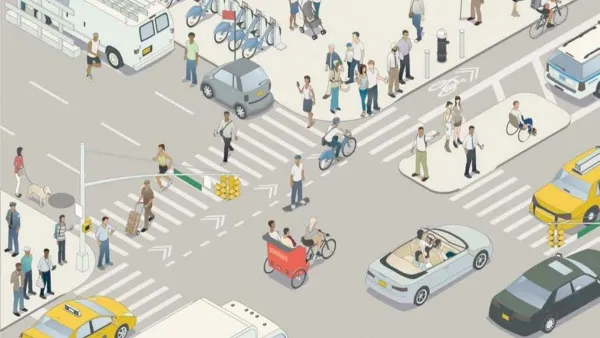The report calls for a wholesale overhaul of U.S. transportation policy to redress the damages caused by decades of auto-centric development.
Divided by Design, a new report from Smart Growth America, highlights the inequities built into the U.S. transportation system and calls for “a fundamental change to the overall approach to transportation.”
Past decisions, including routing the Interstate Highway System through communities of color, dividing and often demolishing them in the process, still shape our built environment. And most importantly, the foundation of the modern transportation program was built on models, measures, and standards with roots in this era.
The report notes that “Because it is difficult and unsafe to reach daily needs without a vehicle in much of the United States, transportation has long acted as an economic barrier in the United States.” Thanks to the perpetuation of car-oriented infrastructure, “Fewer than 10 percent of Americans currently live within walking distance of frequent transit, like buses or metro trains.”
Using Washington. D.C. and Atlanta as examples, the report quantifies the damage created by urban highways and compares it to the different development paths of neighborhoods where planned freeways were never built.
The report calls for sweeping changes in transportation policy. “Small, niche, siloed efforts … cannot repair past damage or keep up with the new barriers being created by new projects. To create a system that serves everyone and halts the practice of benefiting certain people at the expense of others, we need a new set of governing principles, standards, models, and measures, embedded in every single project and program.” According to the report, “Our scales don’t need rebalancing, they need replacing.”
FULL STORY: Divided by Design

National Parks Layoffs Will Cause Communities to Lose Billions
Thousands of essential park workers were laid off this week, just before the busy spring break season.

Retro-silient?: America’s First “Eco-burb,” The Woodlands Turns 50
A master-planned community north of Houston offers lessons on green infrastructure and resilient design, but falls short of its founder’s lofty affordability and walkability goals.

Delivering for America Plan Will Downgrade Mail Service in at Least 49.5 Percent of Zip Codes
Republican and Democrat lawmakers criticize the plan for its disproportionate negative impact on rural communities.

Test News Post 1
This is a summary

Test News Headline 46
Test for the image on the front page.

Balancing Bombs and Butterflies: How the National Guard Protects a Rare Species
The National Guard at Fort Indiantown Gap uses GIS technology and land management strategies to balance military training with conservation efforts, ensuring the survival of the rare eastern regal fritillary butterfly.
Urban Design for Planners 1: Software Tools
This six-course series explores essential urban design concepts using open source software and equips planners with the tools they need to participate fully in the urban design process.
Planning for Universal Design
Learn the tools for implementing Universal Design in planning regulations.
EMC Planning Group, Inc.
Planetizen
Planetizen
Mpact (formerly Rail~Volution)
Great Falls Development Authority, Inc.
HUDs Office of Policy Development and Research
NYU Wagner Graduate School of Public Service





























